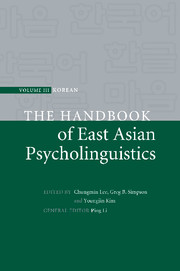Introduction: Advances in Korean psycholinguistics
Published online by Cambridge University Press: 05 June 2012
Summary
The basics of Korean
This chapter briefly introduces some characteristics of the Korean language and its writing system and gives an overview of the chapters treated in this volume on Korean psycholinguistics.
Korean has the eleventh largest group of speakers in the world, approximately 73 million. Its dialects are mutually intelligible except for the Jeju (Cheyjwu) Island dialect, which retains old forms but is becoming endangered.
Korean has an SOV (subject-object-verb) head-final feature like Japanese and unlike Chinese or English. Sentence types such as declarative, interrogative, imperative and promissive are distinguished by means of markers that appear at the end. Nominals take case markers or postpositions after them and verb stems take tense, modal, speech level, and S-type markers linearly in that order after them agglutinatively. It is similar to Japanese in this respect. Honorification is a pragmatically motivated syntactic agreement phenomenon to show the speaker's respect for the subject. Speech levels mark the speaker's various attitudes toward the hearer including (non-)politeness. Honorification in Korean is a little more grammatical than in Japanese. The three East-Asian languages are topic-prominent, with object deletion via topicality unlike pro-drop languages such as Romance languages, although Korean and Japanese have subject or nominative markers as well as topic markers, unlike Chinese. Korean and Japanese have SOV in both matrix and embedded Ss unlike German. Korean and Japanese have a null argument in a relative clause, which is coreferential with the head noun on the right hand side of the clause.
- Type
- Chapter
- Information
- The Handbook of East Asian Psycholinguistics , pp. 1 - 20Publisher: Cambridge University PressPrint publication year: 2009



